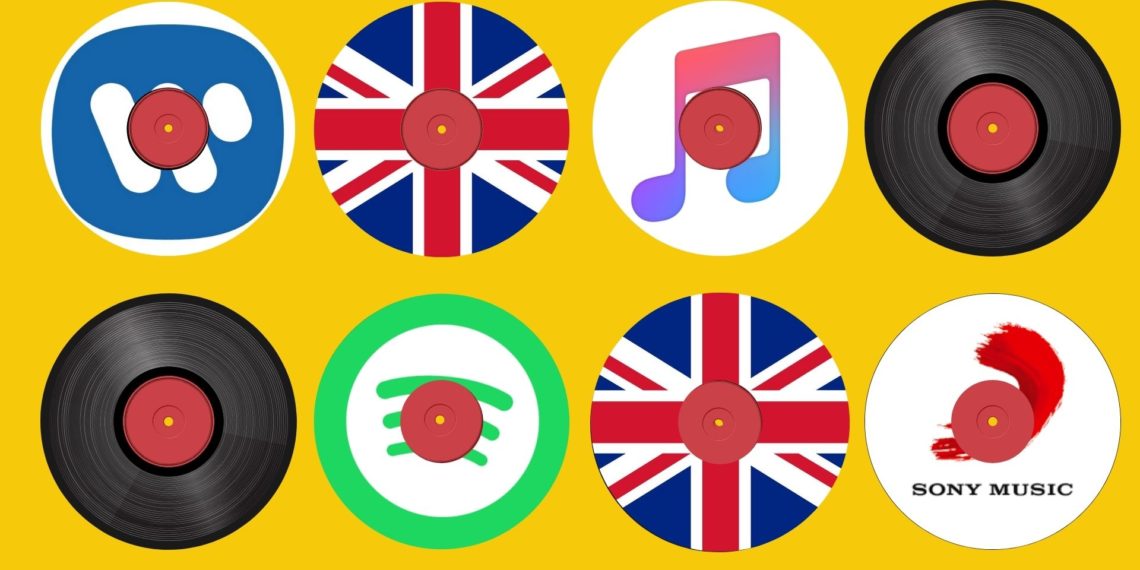With the arrival of streaming, a number of observers predicted the reign of independent labels and the end of the traditional major companies. Nevertheless, the latter seem more powerful than ever today. Former enemies, majors and streaming services walk hand in hand.
Launched in 2008 by platforms such as Spotify or Deezer, paid subscription streaming is the number 1 source of revenues of the recording music industry. Main responsible of its growth, it now represents 11.4 billion dollars growth (56 % of the total revenue) (1). The sector leaders such as Spotify, Deezer and Apple Music have witnessed a 25 % increase of their revenues in 2019 (2).
Paradoxically, as many forecasted the death of majors with the end of barriers to market entry, they seem to have consolidated their leading position. In 2019, the 3 dominant actors of the industry (Universal, Warner and Sony) have captured 16.34 billion dollars (a whooping 81% of the total revenue) (3)(4)(5). What are the reasons of such a dominance, as in the same time releasing music has never been so cheap?
An abundance of supply… hurting independent artists
In his 2005 book The Long Tail Chris Anderson claimed that hits and albums concentration were a phenomenon based on scarcity. Indeed, a record store owner has limited space in his shop. It will be more profitable to put in his store an album that will sell 500 copies rather than one which will sell only 5 copies. In the internet era, storage capacity has become infinite : noe need to produce global hits. His forecast was that the 21st century would be a time of niches, with hundreds of mini hits emerging (6).
15 years later, one can witness how his prediction was spectacularly wrong. With the decrease of release costs, streaming services have been overwhelmed with a continuous flow of new music. Music supply is so huge that users seem to be lost in front of this mass influx every Friday (Almost 280 000 songs are added to the platforms every week!)(7). While the platforms’s storage space is infinite, time that users can spend searching for new songs is not.
Indeed, it has been proven that only 5 % of the streaming services clients use the seach bar when they connect to the app (8). Most of them prefer playing a thematic or personalised playlist… whom most of the artists belong to a major company. Indeed, they enjoy preferential relationships with the services. This situation allows them to put their own artists in the playlists (9). Paying deals between majors and streaming services don’t exist anymore, but it can’t be argued that the overwhelming majority of songs broadcasted in playlist belong to the 3 majors (10).
In addition, the compensation model of streamng services, based on a CPL (cost per listen) intrinsically favours global hits. Only major companies have the capacity and the statistical tools to discover and push hits. If we take a look at the top 50 SNEP (the 50 most listened songs of the week in France), 45 of them are made by artists signed to a major label (11).
90%. That’s also the streaming revenues share that the 2% most listened artists have earned (12). Far from helping independence and diversity, streaming reveals itself as a terrific weapon, allowing a few oligopolistic companies to share most of the cake.
A decrease of variable costs on the back-catalogue, giving an advantage to already established actors
Music is a semi-public good, in the sense that it is not destroyed after its first use. This good’s production includes fixed costs (composers, artwork designers, music videos,…) and variable costs (CD, distribution,…). To be a bit more schematic, one can say that fixed costs are production costs and that variable costs are reproduction costs
The streaming represented an enormous revolution on this matter, with the fall to nearly zero of variable costs on the back-catalogue. The back-catalogue is a catalogue made of the totality of the recordings, released in the years before, whose master’s rights belong to the label.
Là où auparavant les labels devaient presser de nouveau les CD des années précédentes pour les distribuer aux disquaires, il suffit aujourd’hui à l’utilisateur de la plateforme de stream de cliquer sur l’album pour le réécouter. This logic of use (and not of buying ) has changed the distribution of the revenues. A CD sale will generate around 12 euros, while a stream only represents 0.0037 euros (13). However, the CD sale limits the future revenues of the object, while streaming can be the source of infinite revenues for the label, as long as the song continues to be listened.
In this situation, back-catalogues become really profitable again for established labels While signing up-and-coming artists is a risky business, hvaing a large back catalogue is durable and sure source of revenue. For a major such as Universal, the number of streams of the back-catalogue artists (Queen, les Beatles, Eminem, 2Pac…) often reach those of contemporary superstars. It allows them to improve their margins and to increase investments on up-and-coming talents, ensuring a sustainability for the label.
A lab for the signing of new talents
One of the oddities of the music industry is that it involves a tremendous financial risk. The difficulty to predict the crowd’s tastes represents the main reason.In addition, the cost of producing a musical project is high (an album price can go from a dozen thousand euros for a rising artist to hundreds of thousands for an established superstar) (14).
Each new artists signing is risky for a label, as it will have to pay an upfront, music videos, composers, studio sessions, a mixing ingeneer and a mastering one, without the guarantee of the upcoming album’s success.
Nevertheless, streaming allows labels to predict more easily the future profitability of their talents, and therefore to diminish the risk of a new signing.
When, in the CD period, A&R had to listen to hundreds of demos and decide with their guts the next signing, they can now use a large amount of data to help them choose who to sign.
The arrival of short listening sevices, such as TikTok or Triller, have even reduced the risk for the release of a single.With these apps, the artists can release a snippet of 10 to 15 seconds of an upcoming song. Using data such as the number of repays or the interactions with the video, the label will choose or not tho release this song as a single. This strategy allowed french rapper Gambi (Warner Music) to hit the number 1 spot of the SNEP top 50 three times in a row, with the reacts of his fans to his Triller videos (15)(16)(17).
This change of paradigm (a switch from labels specialised in the dicovery of talents to labels having the role of a “bank”, giving budgets to artists to develop themselves) reinforced majors. Indeed, the latter have an obvious advantage when it comes to pay the high advances, which «hype» artists demand. They have become an essential starting point in their carreers, using their expertise to make them advance from an ephemeral hype to an established superstar.
Despite the fall of production costs and the end of entry barriers, streaming services have created a business model allowing the 3 majors (Universal, Warner and Sony) to take the lion’s share. The next debates in the industry should be now focused on how to create a business model allowing diveristy and independence. A user-centric approach (i.e. the money paid by the subscription of an user would go directly to the pocket of the artists he listens to) could be the future of these srrvices, whose growth seems to be unstoppable. Finally, the emergence of new actors such as Believe could represent a threat to the major companies’ dominance in the next years.
- https://www.ifpi.org/media/downloads/GMR2019-en.pdf
- https://investors.spotify.com/financials/press-release-details/2020/Spotify-Technology-SA-Announces-Financial-Results-for-Fourth-Quarter-2019/default.aspx
- https://www.billboard.com/articles/business/8550955/universal-music-group-2019-earnings-revenue-ipo-plans-umg
- https://www.wmg.com/news/warner-music-group-corp-reports-results-fiscal-fourth-quarter-and-full-year-ended-september-3-6
- https://www.musicbusinessworldwide.com/sony-music-revenues-grew-by-over-250m-in-calendar-2019-topping-4bn/
- Chris Anderson (2005), The Long Tail: Why the Future of Business Is Selling Less of More, Londres: Pearson
- https://www.musicbusinessworldwide.com/nearly-40000-tracks-are-now-being-added-to-spotify-every-single-day/
- Ahmed Kachkach (2016), Analyzing user behavior and sentiment in music streaming services
- http://mediamerica.org/musique/la-playlist-nouvel-outil-de-promotion-des-majors/
- https://korii.slate.fr/tech/spotify-vs-majors-guerre-vraiment
- https://snepmusique.com/les-tops/le-top-de-la-semaine/top-albums/?categorie=Top%20Singles
- https://www.musicbusinessworldwide.com/the-odds-of-an-artist-becoming-a-top-tier-earner-on-spotify-today-less-than-1/
- https://www.clubic.com/telecharger/logiciel-musique-et-streaming/article-848644-1-streaming-musical-quelle-remuneration-artistes.html
- Leslie Meier (2016), Making Media: Production, Practices, and Professions, Amsterdam: Amsterdam University Press
- https://snepmusique.com/les-tops/le-top-de-la-semaine/top-albums/?categorie=Top%20Singles&semaine=39&annee=2019
- https://snepmusique.com/les-tops/le-top-de-la-semaine/top-albums/?categorie=Top%20Singles&semaine=45&annee=2019
- https://snepmusique.com/les-tops/le-top-de-la-semaine/top-albums/?categorie=Top%20Singles&semaine=06






